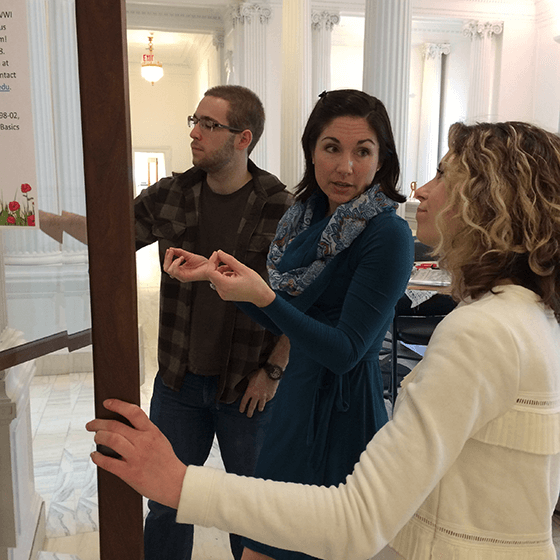Student Curated Display is Work of New History Class
WEST LONG BRANCH, N.J. — Monmouth University will open an exhibit on April 13, 2017 marking the centennial of the entrance of the U.S. into World War I. It is the first exhibit developed and curated by the members of a new experiential history class.
Specialist Professor of Public History Melissa Ziobro says that the initial outing of the Museum and Archives Management Basics class has been quite successful.
“Since this is the first time we’ve offered this class,” said Ziobro, “we thought it would be nice if the students could run the exhibit. As we worked through our textbook, we also worked through the creation of the exhibit.”
Ziobro said that increasing numbers of students studying history at Monmouth University are examining career options other than history education. As such, Ziobro felt that classes that teach skills would be invaluable for students seeking careers in museums, archives or at historical sites.
Junior history and anthropology major Richard Adamczyk thinks she’s correct. “We’re learning exactly how to set up exhibitions, how to manage museums, what kinds of nuts and bolts go into all of that and I feel like this class really prepares us for starting our careers.”
Instead of gathering artifacts herself, Ziobro crowdsourced the artifacts from the Monmouth community. By gathering them in advance, Ziobro said that she was able to identify “holes” in the collection as the students began to develop the exhibit. She then taught students how to use resources, such as the National Archives, to develop supplemental materials.
Ziobro said that while these students are going to graduate with an important entry on their resumes and information for their portfolios, they will also be able to confidently speak with industry professionals about how they curated and installed this exhibit.
“It’s increasingly important in this competitive environment that the students [graduate] with skills they can use,” Ziobro noted. “The students are learning very real, concrete skills that they can put to use on their first day of work in one of these fields – or translate them to other related fields.”
Monmouth students will “stand head and shoulders above graduates from schools whose programs don’t incorporate these skills,” she said.
THE GREAT WAR
World War I is often called “the first modern war,” as mechanized tanks, airplanes, armored cars and field telephones made their first significant appearances in battle, but these technological advances did not lower the number of casualties.
“A lot of people tend to forget how terrible wars really are after a couple of decades,” remarked Adamczyk. “It’s important to remember what it was actually like; especially a war of this magnitude.”
His classmate, Ashley Parker, a senior anthropology major, said the students wanted to place particular emphasis on the human face of this war because most of the artifacts on loan can be linked to ancestors of community members.
“I know that a lot of artifacts on display show Fort Monmouth, which is 15 minutes from our campus,” said Parker. “We get to humanize the war, which is something that usually gets left unnoticed because it’s tanks, planes, and the ‘horror of war,’ rather than the people in the war who were actually doing the fighting.”
Seeing artifacts on display, Adamczyk said, “makes you feel exactly how real this war was.” When asked if they could pinpoint something specific about World War I that they learned by putting the exhibit together, Adamczyk replied, “One thing that surprised me was how unprepared American really was for the war.” He said this ran counter to the narrative he had been taught that “America swooped in to save the day.”
Parker noted that she was startled by the fact that much of the war’s mobilization took place in New Jersey. “[I] didn’t think of New Jersey as being a place to prepare for war, but Fort Monmouth, where the Signal Corps were, was one of the main training bases. A lot of technology was developed there. After training, the troops were moved to Hoboken and then they were shipped to Europe, to the Western Front.”
According to the United States World War One Centennial Commission, New Jersey contributed 72,946 conscripts and 46,960 volunteers to the war. Counting those already in service, by war’s end more than 140,000 New Jerseyans served.
Ziobro said the students “are doing a spectacular job. It’s been an incredible learning experience and I think it will continue to be.”
The exhibit is on display in the university library for the next year. Ziobro hopes to develop additional related programming to “continue the discussion about the Great War in New Jersey.”
OPENING EVENTS
The exhibit will open on April 13, 2017 at 5:00 p.m. with a reception. The artifacts will be on display throughout the first and second floors of the university library for the next year.
Also on April 13, following the reception, Geoffrey Dyer, author of acclaimed World War I remembrance, The Missing of the Somme, will give a talk in Pollak Theatre, beginning at 7:00 p.m.
Both events are free and open to the public.

